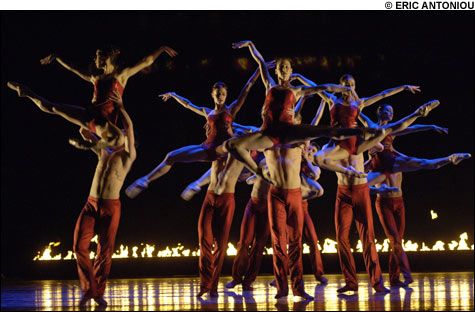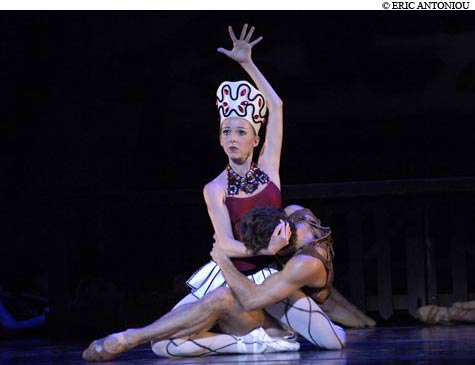
LE SACRE DU PRINTEMPS: Lighting up the Wang in Jorma’s Elo new ballet to Stravinsky’s score. |
“Burning down the house” is a metaphor, but at the Wang Theatre last weekend, the Boston Fire Department was on hand to ensure that it remained one. All the same, audiences had a hot time at Boston Ballet’s season finale, where, in Jorma Elo’s incendiary Le Sacre du Printemps, it wasn’t just the flames flickering in the background that lit up the stage.
It was fitting that Boston Ballet should bid farewell to the Wang — it will stage all its productions at the Opera House next season — with “Diaghilev’s Ballets Russes Centennial Celebration.” Serge Diaghilev’s company kicked ballet into the 20th century, with its avant-garde composers (Stravinsky, Debussy, Ravel, Prokofiev) and choreographers (Fokine, Nijinsky, Nijinska, Balanchine) and designers (Benois, Bakst, Picasso) and dancers (Nijinsky, Karsavina, Lifar, Danilova). Put Schéhérazade, Firebird, Petrouchka, Les Noces, or Apollo up against most contemporary choreography and it’s the newer stuff that seems dated. In this trio of Ballets Russes originals — Balanchine’s The Prodigal Son (1929), Fokine’s Le Spectre de la Rose (1911), and Nijinsky’s Afternoon of a Faun (1912) — plus resident choreographer Elo’s version of the most famous Ballets Russes piece of all, Boston Ballet looks forward as well as back.

These four works are also modern in their focus on the isolation of the individual. Nineteenth-century story ballets are about community and romance; only Giselle and La Sylphide end in death and desolation. Balanchine’s Prodigal is fleeced by the Goons, seduced by the Siren, and deserted by his two friends; when at the end he crawls back into the embrace of his father, it’s as if he were re-entering the womb. In Le Spectre de laRose, a young woman returns home from a ball bearing a rose (that an admirer has given her?) and falls asleep in an armchair, whereupon she’s visited by the title apparition, the man of her dreams, with whom she dances — but was it all a dream? At the end, she’s alone, clutching her rose. Afternoon of a Faun opens with our hero in solitary splendor atop a rock, playing his flute and munching on grapes — until some nymphs troop by on their way to bathe in the lake. He cavorts briefly with one of them; she drops a silken scarf before slipping away (he’s looking in the opposite direction), and he takes it back to his perch, stretches it out, lies on it, masturbates. In Nijinsky’s Sacre, a virgin is chosen from the community to be sacrificed to the earth. Elo’s ballet takes up the same theme.
Boston Ballet last did Prodigal in 2003, with Yury Yanowsky as the opening-night Son. He’s as charged now as he was then, and dancing as well as he ever has, his Prodigal a wild child who’s cocky and optimistic and more than a little incredulous when — having broken free of his overbearing father and his two sisters and taken his goods and left — he finds himself crucified and stripped. It’s an intensely physical performance; the way he hangs off the pillar cross (which quintuples as picket fence, table, crib, and ship), he could be preparing to model for Titian’s late, great Pietà. Jared Redick doesn’t have Yanowsky’s force, but in his three performances he offered an intelligent reading, his Prodigal angry at the outset, comic in the middle, devastated at the end. These were Redick’s final performances; he’s retiring to focus on heading the Boston Ballet School’s Norwell studio.
The three Sirens were of a piece, all warmer and more insinuating than the pair I saw — Agnès Letestu and Marie-Agnès Gillot — in Paris in 2003. Opposite Yanowsky, Melanie Atkins (who also danced Prodigal in 2003, though not with him) was the most subtle and fluid, promising rather than proffering. She’s also retiring, to become the children’s ballet mistress for Boston Ballet School — our loss, the kids’ gain. Kathleen Breen Combes, who partnered Redick, was more aggressive in the projection of her shoulders and pelvis; Melissa Hough, in a single performance Sunday night, was the lushest and most weighted. And it would be hard to imagine a better father than Arthur Leeth, who’s the embodiment of patriarchal, good and bad.

THE PRODIGAL SON: Melanie Atkins and Yury Yanowsky make this even better than it was in 2003 |
The vulnerability of this Prodigal is a trademark — mostly a good one — of Boston Ballet, and it showed as well in Spectre and Faun. Erica Cornejo was a wide-eyed, spontaneous dreamer, Larissa Ponomarenko a refined, aristocratic one with a long, long line. I would like to have seen Ponomarenko with Pavel Gurevich, who was the biggest and most poetic of the three Spectres — not that she didn’t look fine with a fresh and athletic James Whiteside. Altankhuyag Dugaraa was the revelation in Faun, all attitude (“I’m the James Dean of Fauns,” he seemed to say) and slow, animal movement. His two Nymphs, Heather Myers and Josephine Pra, matched him in stylization. The six corps nymphs did a good job with the frieze-like — shoulders square to the audience, feet in profile — movement, which has much in common with the Siren’s.